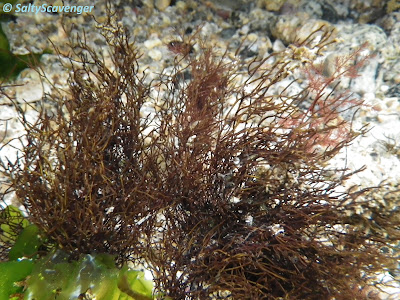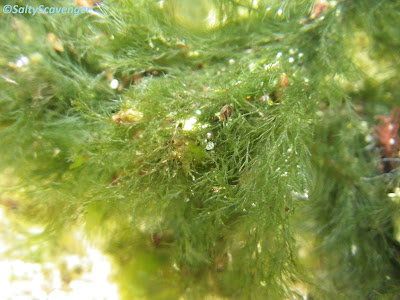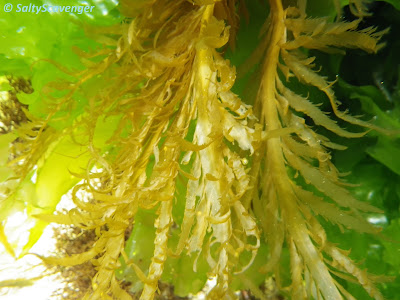The bay experiences a dynamic regime, alternating between periods of erosion (stony) and deposition (sandy).The underlying substrate is boulders and bedrock, however, variable amounts of sand may be deposited on top, sourced from the sand bar situated offshore. The communities encountered reflect the alternation between these regimes.
For the past 18 months the shore has been stony and a series of rockpooling visits has documented the slow colonisation and succession of the sea shore communities of the newly available substrate.
Please see previous blog posts:
http://thesaltyscavenger.blogspot.nl/2015/07/rockpooling-destination-revisit-lands.html
http://thesaltyscavenger.blogspot.nl/2014/05/revisit-lands-end-peninsular-april-2014.html
http://thesaltyscavenger.blogspot.nl/2014/02/rockpooling-destination-lands-end.html
Habitat classification:
Below are images of organisms you may encounter whilst rockpooling in these habitats:
Please see previous blog posts:
http://thesaltyscavenger.blogspot.nl/2015/07/rockpooling-destination-revisit-lands.html
http://thesaltyscavenger.blogspot.nl/2014/05/revisit-lands-end-peninsular-april-2014.html
http://thesaltyscavenger.blogspot.nl/2014/02/rockpooling-destination-lands-end.html
Habitat classification:
Substrate
|
LR (Littoral rock)
|
LS (Littoral Sediments)
|
|||||
Habitat
|
LR.HLR (High energy littoral rock)
|
LR.MLR (Moderate energy littoral rock)
|
LR.FLR (Features of littoral rock)
|
LS.Lsa (Littoral Sand)
|
|||
Biotope complex
|
LR.HLR.MusB (Mussel and/or barnacle communities)
|
LR.MLR.BF (Barnacles and fucoids on moderately
exposed shores)
|
LR.FLR.Rkp (Rockpools)
|
LR.FLR.Eph (Ephemeral green or red seaweed
communities)
|
LR.FLR.Lic (Lichens and small green algae on
suprallitoral and littoral fringe rock)
|
LS.LSa.St (Strandline)
|
|
Biotope
|
LR.MLR.BF.Fser.R (Fucus serratus and red seaweeds
on moderately exposed lower eulittoral rock)
|
LR.FLR.Rkp.Cor (Coralline crust dominated shallow
eulittoral rockpools)
|
LR.FLR.Rkp.SwSed (Seaweeds in sediment-floored
eulittoral rockpools)
|
||||
Below are images of organisms you may encounter whilst rockpooling in these habitats:
 |
| The rocky shore during the current visit in June 2015, shows little variation from April 2015. The only noticeable difference is an increased 'bleaching' of ephemeral green seaweed by the stack. |
 |
| The rocky shore in April 2015 |
 |
| A stream flows over the cliff, onto the shore and beneath the cobbles and boulders. |
 |
| Rough periwinkles (Littorina spp) occur on the littoral fringe and upper shore bedrock of the stack. |
 |
| Small periwinkles (Melarhaphe neritoides) seek refuge within the pits of the larger boulders. |
 |
| Small periwinkles (Melarhaphe neritoides) seek refuge within a pit of a large boulder. |
 |
| Rough and small periwinkles (Littorina spp and Melarhaphe neritoides) aggregate within crevices of a large boulder. |
 |
| Rough and small periwinkles (Littorina spp and Melarhaphe neritoides) aggregate within crevices of a large boulder. |
The first barnacles are beginning to appear on the boulders that were once covered by sand.
|
 |
| Sparse barnacles on boulders that were once covered by sand. |
 |
| Since April 2015, a strandline of seaweed has formed on the shore and much seaweed has collected within the cave. Habitat classification: LS.LSa.St (Strandline) EUNIS: A2.21. |
 |
| Seaweed has been washed up among the boulders of the upper shore. |
 |
| The barnacle communities support beadlet anemones (Actina equina), Limpets (Patella spp) and ephemeral green seaweeds. |
 |
| Fucus serratus |
 |
 |
| Hypoglossum hypoglossoides |
 |
| Black scour weed (Ahnfeltia plicata) |
 |
| Rhodymeniales |
 |
| Rhodophyta (Polysiphonia spp) |
 |
| Cladophora spp |
 |
| Polyides rotundus |
 |
| Corallina officinalis |
 |
| Rhodophyta |
 |
| Rhodophyta |
 |
| An amphipod encased within green seaweed. |
 |
| An amphipod encased within green seaweed. |
 | ||
| Gastropoda |
 |
| Gastropoda amongst Claodphora spp |
 |
| Gastropoda amongst Claodphora spp |
 |
| Hydrozoa |
 |
| A green sea slug (Elysia viridis) |
 |
| A nudibranch |
 |
| A nudibranch |
 |
| An aggregation of sea hares (Aplysia punctata) |
 |
| Aplysia punctata |
 |
| Aplysia punctata |
 |
| Flat periwinkle (Littorina spp) |
 |
| Flat periwinkle (Littorina spp) |
 |
| Flat periwinkle (Littorina spp) |
 |
| The remains of a velvet swimming crab (Necora puber) |
 |
| The remains of an edible crab (Cancer pagurus) |
 A Culdrose helicopter keeps watch over Land's End......soon to be a rare sight... |



























No comments:
Post a Comment